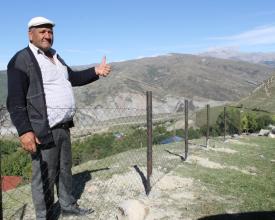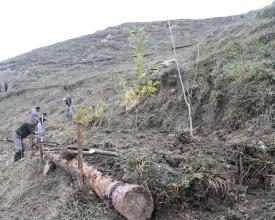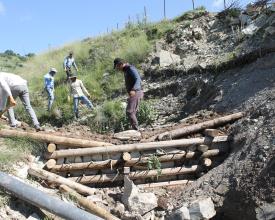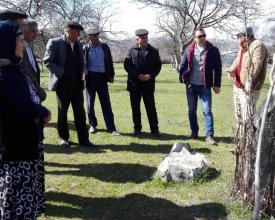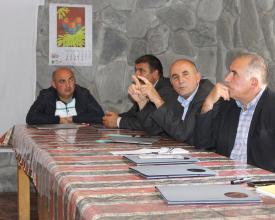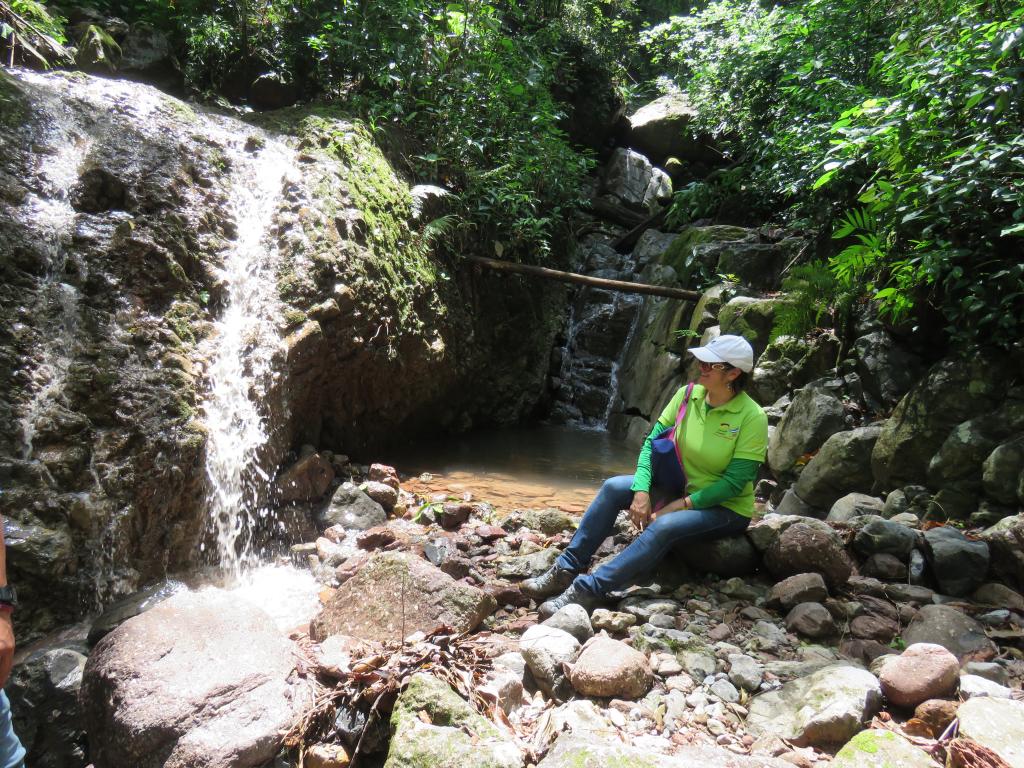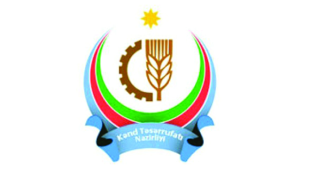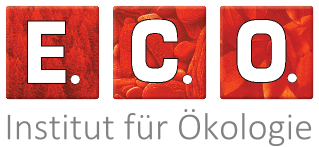
Lutte contre l'érosion basée sur les écosystèmes en Azerbaïdjan
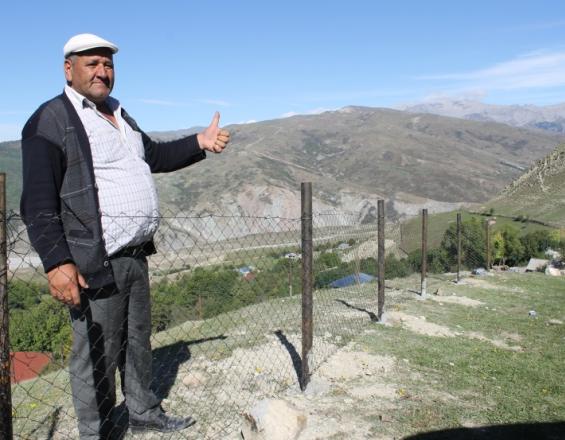
Les pâturages de la région du Caucase du Sud sont soumis à des pressions dues à une utilisation non durable et aux processus de changement climatique. Le programme GIZ "Gestion intégrée de la biodiversité, Caucase du Sud" met notamment en œuvre et teste des solutions abordables en collaboration avec les communautés locales, afin de prévenir l'érosion et de gérer les écosystèmes montagneux de manière durable. Les mesures pilotées comprennent : la stabilisation des pentes et des lits de rivière, la mise en place de prairies de fauche, le boisement, la gestion des vergers et la construction d'une pépinière.
Contexte
Défis à relever
Dans les régions montagneuses de l'Azerbaïdjan, de nombreux pâturages sont en mauvais état. Le nombre élevé de têtes de bétail et les mauvaises pratiques de gestion entraînent une perte de végétation et l'érosion des sols qui s'ensuit. Les pâturages dégradés entraînent une perte de biodiversité et de moyens de subsistance, ainsi qu'un risque accru de glissements de terrain. L'augmentation estimée des températures et la multiplication des phénomènes météorologiques extrêmes accéléreront la dégradation des sols. Même si une augmentation des précipitations peut être bénéfique pour les pâturages, la modification de l'utilisation des terres et l'augmentation de l'évaporation amplifieront l'érosion des sols. Le gouvernement et l'administration du district manquent de coordination et de financement pour la gestion durable des pâturages publics. Les communautés locales sont conscientes du problème de l'érosion, mais les autorités ne proposent pas d'incitations ni d'exemples clairs en matière de lutte contre l'érosion. Pour lutter contre le surpâturage, il faut proposer aux agriculteurs des pratiques alternatives génératrices de revenus, par exemple par le biais d'un concept de gestion intégrée prouvant la valeur économique des services écosystémiques utilisés de manière durable.
Emplacement
Traiter
Résumé du processus
Le Building Block 1 concerne les activités de contrôle de l'érosion du programme. Celles-ci sont pilotées au niveau local et utilisées ultérieurement pour étendre le programme et présenter des solutions réalisables à d'autres communautés. Pour mettre en œuvre les mesures et garantir un résultat durable, le bloc 2 décrit la planification participative et le bloc 3 s'intéresse à l'approche du développement des capacités.
Blocs de construction
Mesures de lutte contre l'érosion
Les mesures de contrôle de l'érosion mises en œuvre contribuent à la conservation de la biodiversité par la protection des ressources naturelles contre les processus d'érosion induits par l'homme et par la réhabilitation des zones dégradées. Une attention particulière est accordée aux causes et aux facteurs sous-jacents de l'érosion afin de développer des stratégies pour améliorer le contrôle de l'érosion au niveau local. Le district d'Ismayilli en Azerbaïdjan a été choisi comme région pilote en collaboration avec des partenaires nationaux.
Différentes mesures de contrôle de l'érosion sont conceptualisées et mises en œuvre grâce à la coopération de partenaires nationaux et locaux, impliquant les parties prenantes concernées, les experts internationaux et locaux et les villageois. Afin de réhabiliter les terres érodées et d'éviter une dégradation supplémentaire des terres, des mesures de contrôle de l'érosion applicables localement sont présentées aux utilisateurs des terres. Ces mesures comprennent des mesures "grises" (terrasses, clôtures) et des mesures "vertes" (boisement, gestion des vergers) et sont associées à des pratiques alternatives génératrices de revenus.
Les avantages socio-économiques et écologiques d'une meilleure gestion des terres et des mesures de contrôle de l'érosion sont contrôlés, documentés et démontrés aux communautés environnantes.
Facteurs favorables
- La compréhension et l'appropriation des problèmes par les utilisateurs des terres sont un élément essentiel de la réussite de la mise en œuvre du contrôle de l'érosion.
- Un échange solide entre les utilisateurs des terres et les scientifiques concernés.
- Développement des capacités des utilisateurs des terres.
- Démontrer la valeur économique des mesures de contrôle de l'érosion.
Leçon apprise
- Une bonne compréhension de la structure sociale de la communauté ainsi que de l'environnement local est essentielle pour le développement d'un concept de contrôle de l'érosion.
- Les mesures doivent être applicables localement et tangibles pour les agriculteurs.
- Des résultats fiables sont nécessaires pour convaincre les agriculteurs (comme le montrent les sites pilotes et les parcelles de suivi du projet).
- Il est essentiel de tester et de démontrer différentes mesures de contrôle de l'érosion afin de montrer quelles mesures ont le plus d'impact sur quelles situations d'érosion et de favoriser la compréhension des solutions.
- Implication des communautés locales dans la construction des mesures (main d'œuvre et matériel).
- Développer un concept de mise à l'échelle, en rendant les expériences locales durables, par exemple un manuel de contrôle de l'érosion pour la région du Caucase du Sud.
Planification participative de l'utilisation des sols
Afin de contrôler correctement la mise en œuvre participative du programme, un "groupe de gestion communautaire" (GGC) a été créé. Les membres du groupe ont été sélectionnés par un vote ouvert à tous les membres de la municipalité. Ils représentent tous les groupes économiques et sociaux qui dépendent des ressources naturelles (éleveurs, apiculteurs, jardiniers, etc.), y compris les femmes et les jeunes. Pendant la phase de planification et de mise en œuvre des mesures de contrôle de l'érosion, le CMG se réunit régulièrement, s'informe de la situation actuelle, discute des défis et décide des étapes suivantes. Le CMG présente sa proposition et ses commentaires sur la gestion des terres publiques (terres communales) aux parties prenantes concernées de l'administration du district, du comité de la propriété, du département de l'agriculture du Rayon et du département régional du ministère de l'écologie. Après avoir intégré les commentaires des différentes parties prenantes, le CMG approuve la mise en œuvre des activités du programme. En outre, le CMG est un mécanisme qui permet de négocier les intérêts divergents et de résoudre les conflits qui surviennent.
Facteurs favorables
- Cartographie des services écosystémiques et compréhension de leur contribution au bien-être humain.
- Existence de connaissances et de compétences traditionnelles concernant l'utilisation collective des ressources naturelles.
- Existence d'une base juridique pertinente (environnement) et volonté des autorités correspondantes de participer au processus de planification.
Planifier et organiser des réunions régulières
Leçon apprise
- Les avantages des mesures appliquées pour les utilisateurs des terres doivent être clairement expliqués aux décideurs.
- L'implication de tous les acteurs concernés est obligatoire pour éviter l'exclusion et les conflits qui pourraient avoir un impact négatif sur le programme.
- Les modérateurs peuvent faciliter le processus de prise de décision (par exemple, l'atténuation des conflits).
- Des experts externes contribueront à la planification et à la mise en œuvre (conseils techniques et institutionnels).
- L'invitation de représentants des ministères compétents aux réunions communautaires peut créer des conflits si la communauté n'est pas au courant des lois et réglementations correspondantes. Il est recommandé d'expliquer au préalable les lois et règlements en vigueur aux membres de la communauté.
- Les femmes, principales utilisatrices des ressources naturelles, ne sont pas toujours impliquées dans la prise de décision. L'implication des femmes aura un impact important sur l'utilisation durable des ressources naturelles.
- La planification participative de l'utilisation des terres doit utiliser les connaissances et les compétences traditionnelles du groupe cible afin de maintenir les bénéfices à long terme.
Développement des capacités humaines pour les mesures de contrôle de l'érosion
Pour soutenir l'approche participative et obtenir des résultats durables, les capacités locales sont continuellement développées. C'est pourquoi des experts internationaux et locaux ont été invités à former les communautés locales à la mise en œuvre et à l'entretien des mesures de contrôle de l'érosion, par exemple : le boisement, l'entretien des pépinières, la gestion des vergers ou l'apiculture. Les réunions locales et régionales entre les communautés servent à promouvoir les activités et à renforcer l'échange de connaissances. Des formations sur l'intégration des services écosystémiques dans la planification du développement sont également dispensées aux autorités locales et aux représentants des partenaires.
Pour permettre les échanges nationaux et régionaux, un manuel sur le contrôle de l'érosion a été élaboré et sera distribué aux ministères concernés, aux institutions de recherche et de formation, aux ONG, aux entreprises de construction et aux experts.
Facteurs favorables
- Les décideurs sont conscients des processus d'érosion et des impacts négatifs futurs
- Les communautés locales ont confiance dans le programme et sont motivées pour participer au processus de mise en œuvre
- L'agenda de renforcement des capacités du programme correspond à l'agenda (de développement) de l'administration du district et des municipalités.
Leçon apprise
- Organiser des formations pratiques sur le terrain plutôt qu'en classe.
- Les formations sur le terrain et l'apprentissage par la pratique rendent les sujets complexes accessibles
- Traduire les formations dans la réalité des communautés locales (par exemple à l'aide d'exemples concrets).
- Respecter les connaissances et les pratiques locales en matière de lutte contre l'érosion
- Incorporer les connaissances locales et traditionnelles dans les formations et refléter les améliorations possibles des mesures appliquées.
- Échanger avec d'autres institutions internationales qui traitent de sujets similaires
- Être sensible aux conflits d'intérêts potentiels lors des formations et des échanges entre les parties prenantes et les partenaires.
- Veiller à ce que toutes les parties prenantes concernées soient impliquées dans le renforcement des capacités.
Impacts
Cette solution a permis de renforcer les connaissances des décideurs et des agriculteurs sur les processus d'érosion et la gestion durable de la biodiversité. Grâce à divers ateliers, formations et excursions, la valeur des services écosystémiques a été expliquée et traduite dans la réalité des participants. L'intégration de la biodiversité a été renforcée par la création d'un groupe de pilotage intersectoriel au niveau du district. L'impact des différentes mesures de contrôle de l'érosion est mesuré grâce à un système de suivi. Les mesures mises en œuvre sont utilisées pour démontrer l'efficacité du contrôle de l'érosion aux parties prenantes et aux communautés voisines, pour susciter l'intérêt des politiciens et des communautés locales pour un contrôle de l'érosion basé sur l'écosystème. L'objectif était de rendre la construction de mesures de contrôle de l'érosion abordable et facile à entreprendre. Dans le village d'Ehen, dans la région d'Ismayilli, plusieurs mesures de bio-ingénierie et d'ingénierie ont été mises en œuvre : des collines escarpées ont été stabilisées par des terrasses et des arbres fruitiers, plusieurs barrages de retenue et un gabion ont été construits dans des lits de rivière érodés, des zones d'érosion par ravinement ont été clôturées et reboisées et des pâturages érodés ont été réimplantés en prairies de fauche. Des pratiques alternatives génératrices de revenus ont été soutenues par des formations et des financements : gestion des vergers, apiculture et production de foin.
Bénéficiaires
Ministère de l'écologie et des ressources naturelles, ministère de l'agriculture, administration du district d'Ismayilli, municipalités locales et communautés locales.
